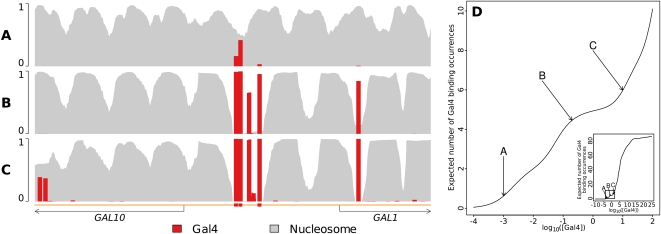Figure 4.
Binding occupancy is highly dependent on factor concentration. (A) At low concentration, Gal4 binding is virtually nonexistent apart from low levels of binding at its annotated binding sites. (B) As concentration increases, Gal4 binds strongly to its annotated sites, displacing nucleosomes there and leading to the stabilization of flanking nucleosome positions, as also illustrated in Figure 1. This stabilization and reorganization allows Gal4 to bind at two additional sites. (C) Increasing Gal4 concentration further eventually leads to strong binding even away from its annotated sites. However, even at this level, Gal4 cannot outcompete many of the strongly positioned nucleosomes, reiterating the importance of including many different DBFs concurrently in the model. (D) Gal4 binding occupancy as a function of Gal4 concentration. Note how occupancy changes more slowly around the seemingly plausible concentration used in B than in any other part of the overall occupancy versus concentration curve (inset), suggesting that while occupancy can be fairly sensitive to concentration on the whole, the cell may sometimes be operating in ranges that are relatively less sensitive.

